Ridge counting is a technique that involves counting the intervening ridges present between the core and delta of a fingerprint. In essence, this method quantifies the ridges between these two reference points, helping to categorize fingerprints based on their ridge counts.
Ridge counting is mostly used for loop patterns. For arches, ridge counting is generally not applicable, and for whorls, ridge tracing is often used.
In short:
- Ridge counting measures the ridges between the core and delta of a fingerprint.
- It is mainly used for loop patterns.
- Arches typically have a zero ridge count, as they lack a delta.
- Whorls often rely on ridge tracing, given their two distinct deltas.
Why there is a Need for Ridge Counts in Fingerprints?
Approximately 60% of people have loop patterns in their fingerprints. This means that you may have 6 loops patterns out of 10 fingers.
Due to these high numbers, there is a need for additional classification measures other than just identifying ulnar or radial loops.
The two main objectives of ridge counting in fingerprints are to:
- Classify: Enhance the classification process by differentiating between similar patterns.
- Improve efficiency: Make fingerprint identification systems more efficient and less time-consuming.
Without ridge counting, it would be difficult to categorize loops into the sub-classifications used in the FBI’s Henry Fingerprint system, which includes:
- Major classification: loops and whorls
- Sub-secondary classification: loops and whorls
- Final classification: loops and whorls
- Key classification: loops
Each of these classifications relies on ridge count or ridge tracing values to categorize and compare fingerprints.
Which Fingerprint Pattern did Ridge Counting is used for?
It is mainly used for the loops but in some cases, they can also be used for the whorls.
For example, in the final classification of the Henry Fingerprint system, ridge counting is employed when there’s a loop or whorl pattern present in the little fingers.
Here are the guidelines and values for using ridge counts in fingerprints in the final classification.
A. In Loops:
- Ridge count of the right little finger is preferred.
- If the right little finger has no loop, ridge count values are used from the left little finger.
- If no loops in either of the pinky finger, whorls are used.
B. For Whorls:
- Simple Whorls:
- Whorl on Right little finger: Counted from left delta to core
- Left little finger Whorl: Counted from right delta to core
- Double Loop Whorls:
- Horizontal double loop:
- Right hand: from left delta to nearest core
- Left hand: from right delta to nearest core
- Vertical double loop:
- ridge counting from left delta to upright core
- Horizontal double loop:
- Accidental Loop Whorls:
- Ridge counting from delta to core which has the least number of ridges.
Rules of Ridge Counting of Loops
The following are ten rules that are used in the ridge count of loops in fingerprint patterns:
Rule 1: Choosing Core and Delta
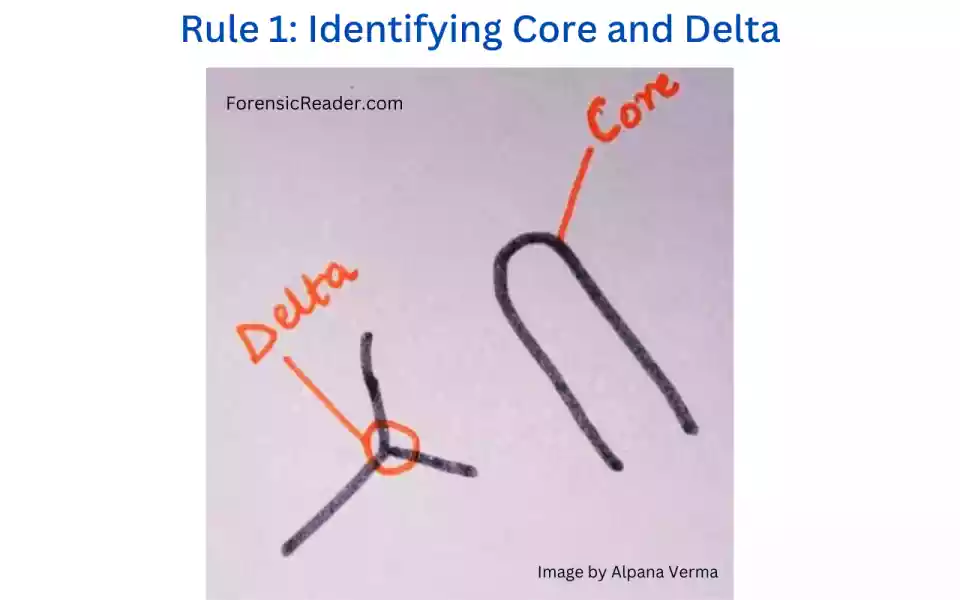
Make sure the fingerprint has a loop pattern with one core and delta. Locate the exact position of the core and delta.
Rule 2: Imaginary Straight line

Once the core and delta are located, draw an imaginary straight line. Make sure you use a ruler to mark a straight line. The pencil should be used to draw the imaginary line.
Rule 3: Not to Include Core and Delta Ridges
The core and the delta are never included in ridge counting. The counting must always be done only of the intervening ridge between them.
Rule 4: Counting Intervening Ridges
The intervening ridges should be counted in numbers between the core and delta passing through the imaginary line.
Rule 5: When Ridges Abruptly End
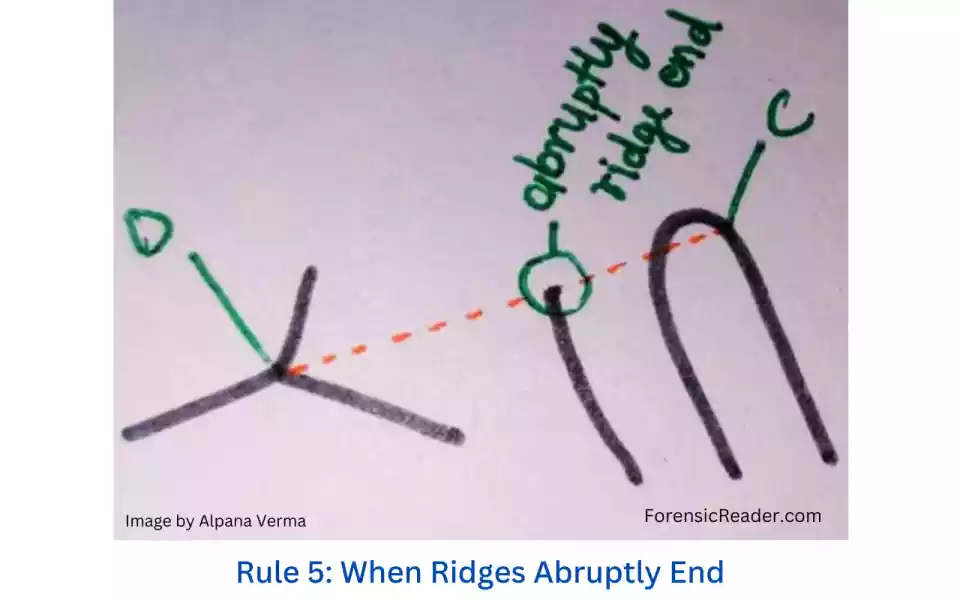
If there is any ridge that ends abruptly passing through an imaginary line is considered as one ridge count.
Rule 6: When Long and Short Ridges Appear
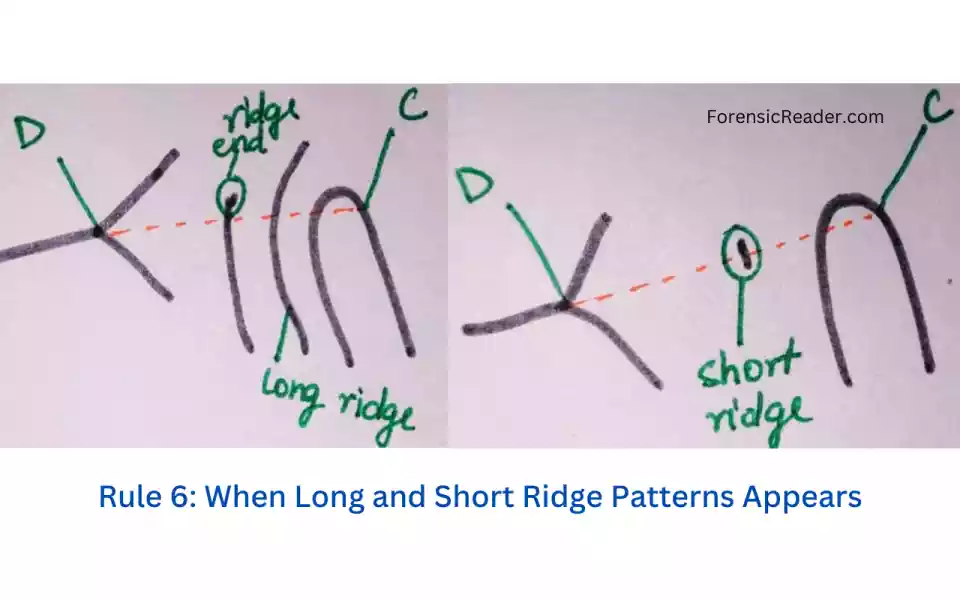
When the loop patterns intervening ridges have long or short patterns, their values should be always counted as one for each.
Rule 7: When Dot or Island Patterns Appear

In case the in-between ridges have a dot or island pattern, the ridge count value of each of them will be one.
Rule 8: When Bifurcation Pattern Appears

In the presence of bifurcation or immediate initial arising of bifurcation, it is counted as two ridge counts.
Rule 9: When Two Ridges Meet
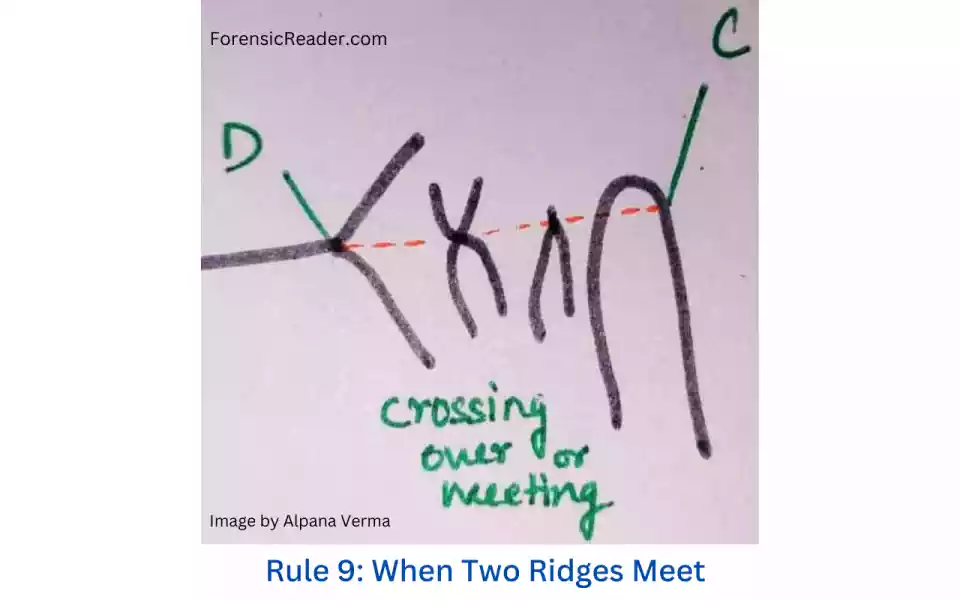
If there is a meeting or a crossing over of two ridges, it is considered to be two ridge counts.
Rule 10: When Ridge Enclosure Pattern Appears
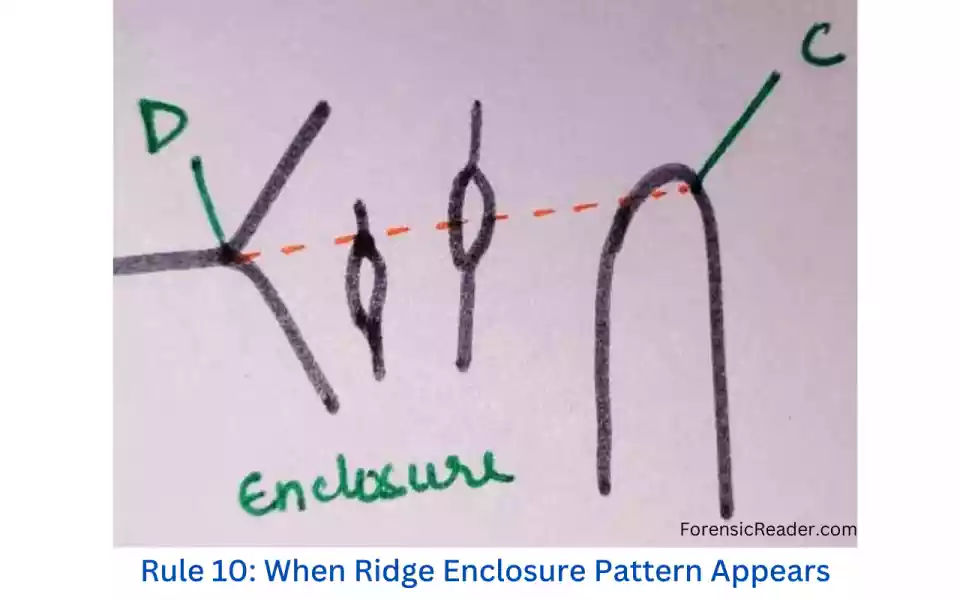
If there is any ridge enclosure (Anastomosis) or its initials, they are valued as two ridges and count values to be two.
How to do Ridge Count in Loops Fingerprint Pattern? With Example
Material Required:
- Inked fingerprints on paper
- Handheld magnifier
- Transparent ruler or scales
Step 1: Getting Ready
Find loops in your finger and then use a fingerprint ink pad and mark the finger ridge over an A4 size paper.
Step 2: Locate Core and Delta
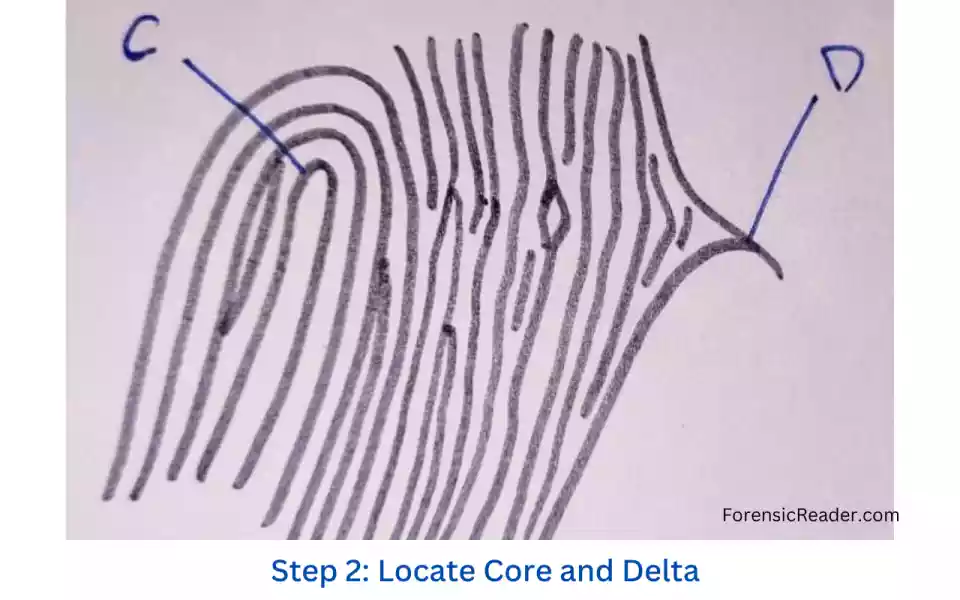
In the inked fingerprint of the loop pattern, first, locate the exact position of the delta and core.
Step 3: Draw an Imaginary line in between
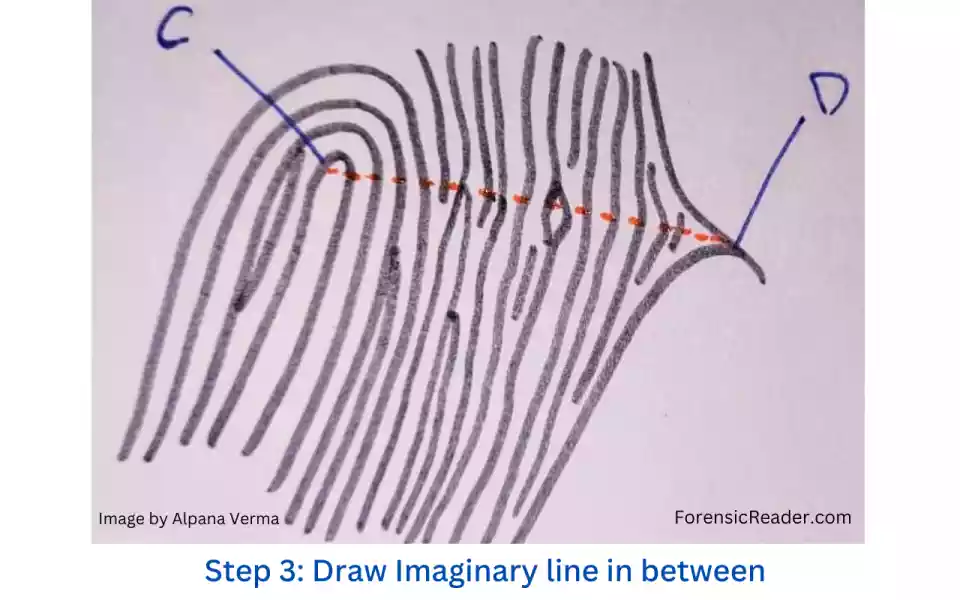
Draw an imaginary line between the core and the delta located as described in the above figure.
Step 4: Don’t Count Core and Delta
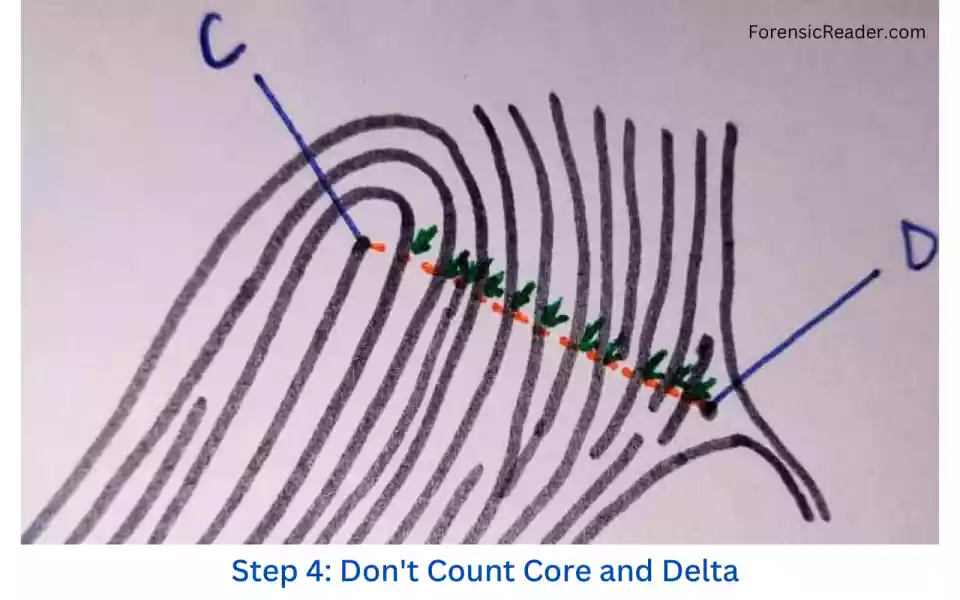
You must not include the the ridge of core and delta when counting ridges.
Step 5: Count the Inbetween Ridges
According to the rules of ridge counting, counting must be done by tracing to the imaginary line.
In the given example, fingerprint patterns such as ridge ending, enclosure, bifurcation, short ridge, and long ridge are taken into consideration.
The total ridge count value for the given example comes to be 17.
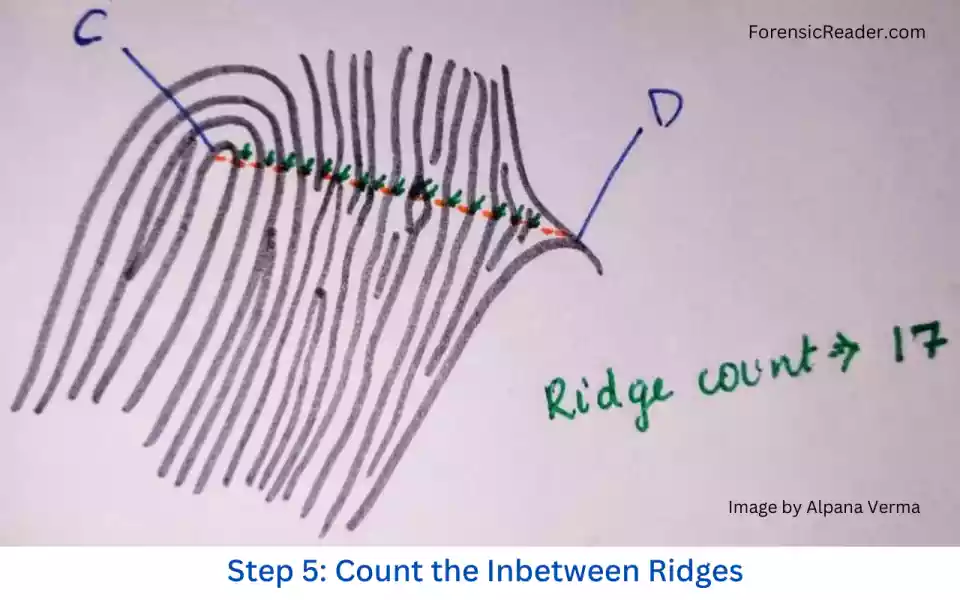
Practical Example of Ridge Counting With Images
Step 1: Locate the exact core and the delta and draw an imaginary line between them.

Step 2: The counting is done according to the rules of ridge counts of fingerprints.
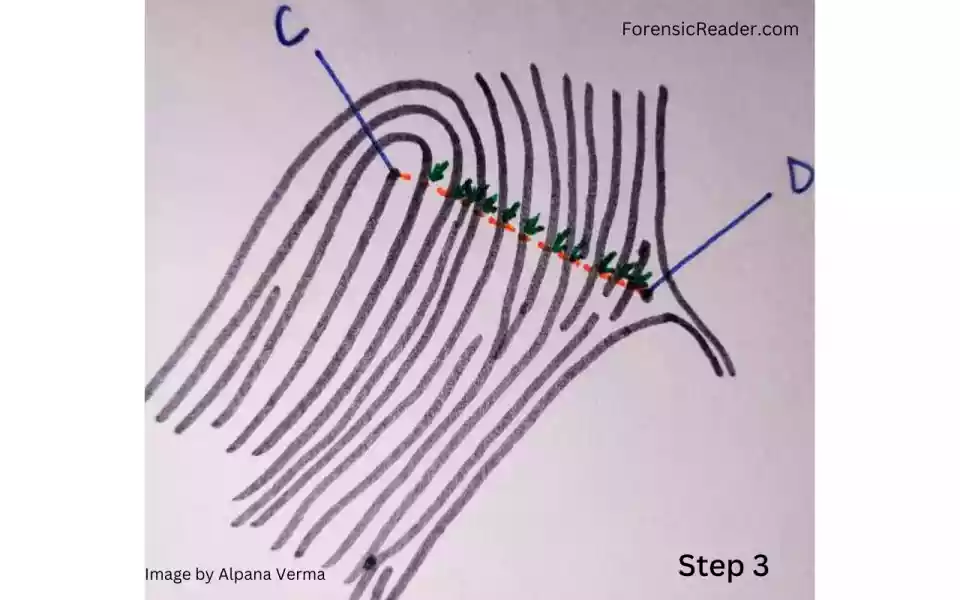
Step 3: For the following example, the total ridge counting is 11.
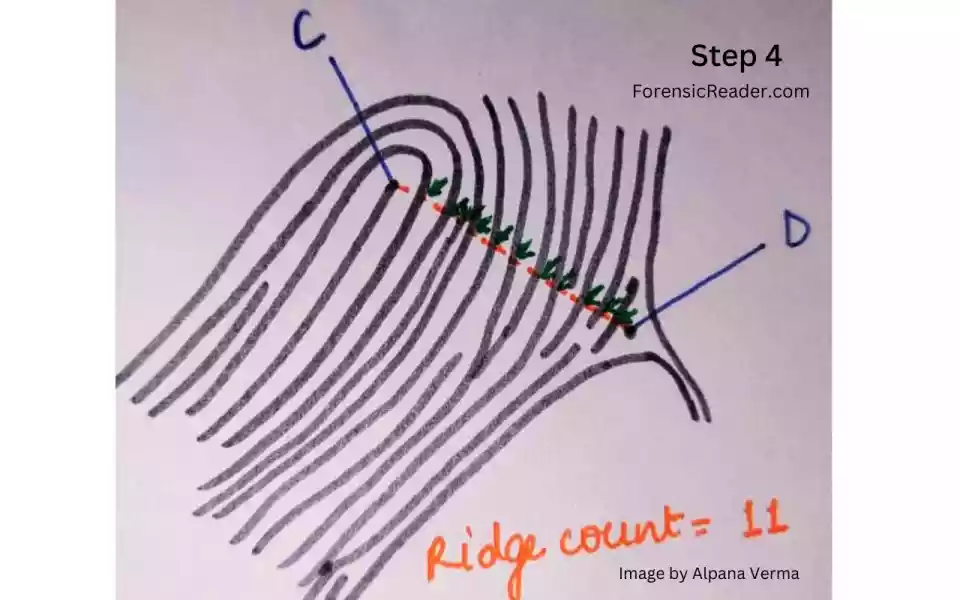
References:
- An analysis of ridge-to-ridge distance on fingerprints [link]
- A review of ridge counting in dermatoglyphics [link]
- Fingerprint comparison. I: Similarity of fingerprints.[link]
- Intelligent Biometric Techniques in Fingerprint and Face Recognition by I. Hayashi, et.al [Book]
- FBI Advanced Latent Fingerprint School By United States. Federal Bureau of Investigation [Books]
- How to Compare Fingerprints at Home? [A Simple Guide]

Alpana Verma holds a master’s degree in forensics from Banaras Hindu University. She has also earned a forensic fingerprinting certification from the Central Forensic Science Laboratory, CBI. Currently, Alpana is a research intern in the entomology field, working within the Zoology department at BHU.

FR Author Group at ForensicReader is a team of Forensic experts and scholars having B.Sc, M.Sc, or Doctorate( Ph.D.) degrees in Forensic Science. We published on topics on fingerprints, questioned documents, forensic medicine, toxicology, physical evidence, and related case studies. Know More.
